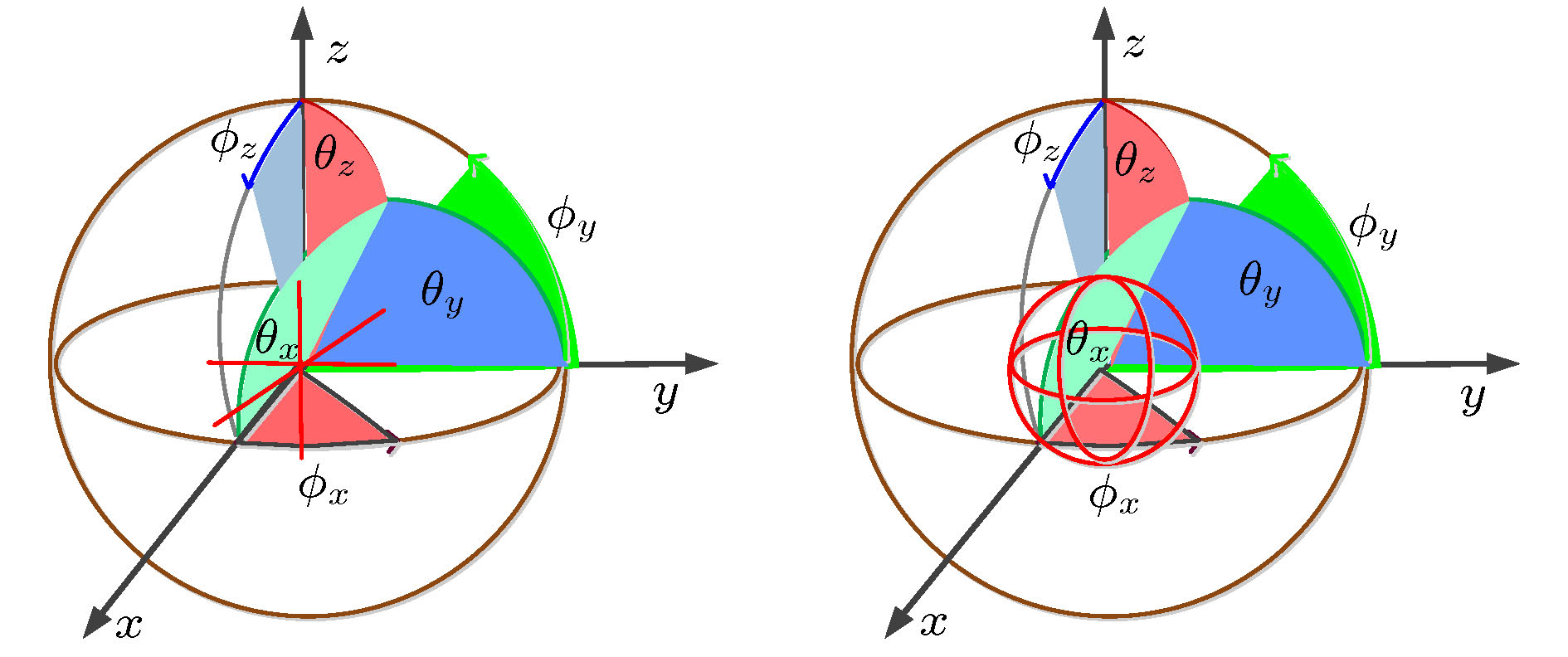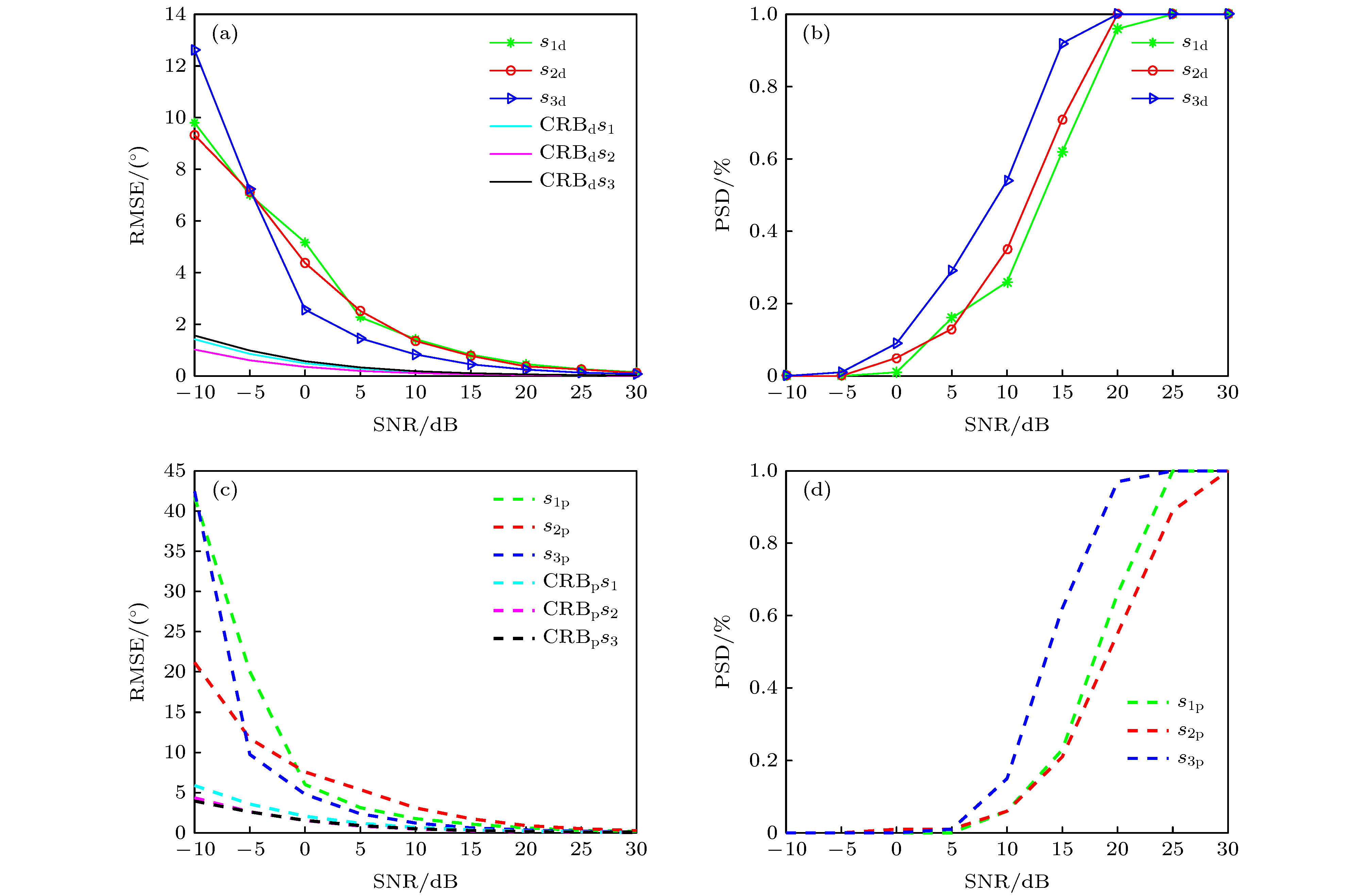-
In this paper, a new designed bistatic electromagnetic vector sensors multiple-input multiple-output radar with long dipoles and large loops is proposed to avoid the low inefficient electromagnetically radiation efficiency of original bistatic electromagnetic vector sensors multiple-input multiple-output radar with short dipoles
$\left(({L}/{\lambda }) < 0.1\right)$ and small loops$\left(2\pi ({R}/{\lambda }) < 0.1\right)$ . The new transmitting and receiving sensors are designed based on the effective length of the electromagnetic vector sensor in practical engineering application. Firstly, the Parallel Factor trilinear alternating least square algorithm is proposed to make full use of the spatial-temporal tensor model for received data after matching filtering. And, the closed-form automatically paired two dimensional Direction of Departure and two dimensional Direction of Arrival can be obtained with the aid of the Parallel Factor trilinear alternating least square algorithm. Furthermore, due to the vector-cross-product Poynting-vector algorithm is failed in the condition of the new designed electromagnetic vector sensors with long dipoles and large loops, an efficient blind estimation method without requiring the prior knowledge of the dipoles’ electric length${L}/{\lambda }$ and loops’ electric radius${R}/{\lambda }$ is detailed derived to deal with the estimation of the transmitting azimuth angle, transmitting polarization angle, transmitting polarization phase difference, receiving azimuth angle, receiving polarization angle and receiving polarization phase difference. And, the estimated transmitting azimuth angle, transmitting polarization angle, transmitting polarization phase difference, receiving azimuth angle, receiving polarization angle and receiving polarization phase difference are also automatically paired without additional angle parameter pair matching process. Finally, the expression of the Cramer Rao Bound is detailed derived for the designed new bistatic electromagnetic vector sensors multiple-input multiple-output radar. The detailed derived Cramer Rao Bound can provide a benchmark for angle parameter and polarization parameter estimation performance. Additionally, simulation results are conducted to verify the better angle parameter and polarization parameter estimation accuracy of the proposed method for the new designed bistatic electromagnetic vector sensors multiple-input multiple-output radar with long dipoles and large loops. Through theoretical analysis and simulation results, it is can be founded that the length of the electric dipole and the circumference of the loops should be suitable selected to guarantee a better estimation accuracy. Thus, the interesting work in this paper can further promote the engineering application of electromagnetic vector sensor in bistatic multiple-input multiple-output radar.-
Keywords:
- long dipoles /
- large loops /
- bistatic multiple-input multiple-output radar /
- parallel factor method /
- blind estimation method /
- joint angle and polarization estimation
[1] Wong K T, Yuan X 2010 IEEE Trans. Signal Process. 59 160
[2] Yuan X 2012 IEEE Trans. Signal Process. 60 1270
 Google Scholar
Google Scholar
[3] Song Y, Yuan X, Wong K T 2014 IEEE Trans. Signal Process. 62 1028
 Google Scholar
Google Scholar
[4] Yuan X 2014 Signal Process. 102 265
 Google Scholar
Google Scholar
[5] Zhang Z, He J, Shu T, Yu W 2018 IEEE Sensors Lett. 2 1
[6] Chintagunta S, Ponnusamy P 2018 Signal Process. 147 163
 Google Scholar
Google Scholar
[7] Liu T T, Wen F Q, Shi J P, Gong Z H, Xu H 2019 IEEE Access 7 120533
 Google Scholar
Google Scholar
[8] Mao C X, Shi J P, Wen F Q 2019 IEEE Access 7 163119
 Google Scholar
Google Scholar
[9] Wen F, Shi J, Zhang Z 2020 IEEE Trans. Veh. Technol. 69 1626
 Google Scholar
Google Scholar
[10] Wen F, Shi J 2020 Signal Process. 175 1
[11] 谢前朋, 潘小义, 陈吉源, 肖顺平 2020 7 074302
 Google Scholar
Google Scholar
Xie Q P, Pan X Y, Chen J Y, Xiao S P 2020 Acta Phys. Sin. 7 074302
 Google Scholar
Google Scholar
[12] Chintagunta S, Ponnusamy P 2018 IET Signal Process. 12 447
 Google Scholar
Google Scholar
[13] Chintagunta S, Subramaniam K, Ponnusamy P 2019 Signal Process. 165 262
 Google Scholar
Google Scholar
[14] Wong K T, Song Y, Fulton C J, Tam W Y 2017 IEEE Trans. Antennas Propag. 65 6057
 Google Scholar
Google Scholar
[15] Li B, Bai B, Zhang Q 2018 IEEE Access 6 9807
 Google Scholar
Google Scholar
[16] Liu B, Li B, Feng Y 2019 IEEE Access 7 27075
 Google Scholar
Google Scholar
[17] Khan S, Wong K T, Song Y, Tam W Y 2018 IEEE Trans. Antennas Propag. 6 3046
[18] Khan S, Wong K T 2019 IEEE Trans. Antennas Propag. 67 5569
 Google Scholar
Google Scholar
[19] Salman K, Wong K T 2020 IEEE Trans. Antennas Propag. 62 1028
[20] Sidiropoulos N D, Bro R, Gianakis G B 2000 IEEE Trans. Signal Process. 48 2377
 Google Scholar
Google Scholar
[21] Tree H L 2002 Detection, Estimation, and Modulation Theory, Part IV: Optimum Array Processsing (New York: Wiley) p927
-
图 4 新型双基地EMVS-MIMO雷达角度参数和极化参数估计星座图 (a) 发射俯仰角和接收俯仰角; (b) 发射方位角和接收方位角; (c) 发射俯仰角和发射方位角; (d) 发射极化角和极化相位差; (e) 接收俯仰角和接收方位角; (f) 接收极化角和极化相位差
Figure 4. Scatter plot of the angle parameters and polarization parameters by using the new designed bistatic EMVS-MIMO radar: (a) Scatter plot of the transmit elevation angle and receive elevation angle ; (b) scatter plot of the transmit azimuth angle and receive azimuth angle; (c) scatter plot of the transmit elevation angle and azimuth angle ; (d) scatter plot of the transmit polarization angle and polarization phase difference; (e) scatter plot of the receive elevation angle and azimuth angle ; (f) scatter plot of the receive polarization angle and polarization phase difference.
图 5 新型阵列角度和极化参数估计性能随信噪比的变化 (a) 角度估计均方误差随信噪比的变化; (b) 角度检测概率随信噪比的变化; (c) 极化估计均方误差随信噪比的变化; (d) 极化检测概率随信噪比的变化
Figure 5. The effect of the SNR for the proposed new bistatic EMVS-MIMO radar: (a) Curves of angle’s RMSE versus SNR; (b) curves of angle’s PSD versus SNR; (c) curves of polarization’s RMSE versus SNR; (d) curves of polarization’s PSD versus SNR.
图 6 新型阵列角度和极化参数估计性能随快拍数的变化 (a) 角度估计均方误差随快拍数的变化; (b) 角度检测概率随快拍数的变化; (c) 极化估计均方误差随快拍数的变化; (d) 极化检测概率随快拍数的变化
Figure 6. The effect of the snapshot for the proposed new bistatic EMVS-MIMO radar: (a) Curves of angle’s RMSE versus snapshot; (b) curves of angle’s PSD versus snapshot; (c) curves of polarization’s RMSE versus snapshot; (d) curves of polarization’s PSD versus snapshot.
图 7 不同电偶极子的长度对角度和极化参数估计性能的影响 (a) 角度估计均方误差随电偶极子长度的变化; (b) 角度检测概率随电偶极子长度的变化; (c) 极化估计均方误差随电偶极子长度的变化; (d) 极化检测概率随电偶极子长度的变化
Figure 7. The effect of the various
${L}/{\lambda }$ for the proposed new bistatic EMVS-MIMO radar: (a) Curves of angle’s RMSE versus various${L}/{\lambda }$ ; (b) curves of angle’s PSD versus various${L}/{\lambda }$ ; (c) curves of polarization’s RMSE versus various${L}/{\lambda }$ ; (d) curves of polarization’s PSD versus various${L}/{\lambda }$ .图 8 不同磁偶极子周长对角度参数和极化参数估计性能的影响 (a) 角度估计均方误差随磁偶极子周长的变化; (b) 角度检测概率随磁偶极子周长的变化; (c) 极化估计均方误差随磁偶极子周长的变化; (d) 极化检测概率随磁偶极子周长的变化
Figure 8. The effect of the various
$2{\text{π}}({R}/{\lambda })$ for the proposed new bistatic EMVS-MIMO radar: (a) Curves of angle’s RMSE versus various$2{\text{π}}({R}/{\lambda })$ ; (b) curves of angle’s PSD versus various$2{\text{π}}({R}/{\lambda })$ ; (c) curves of polarization’s RMSE versus various$2{\text{π}}({R}/{\lambda })$ ; (d) curves of polarization’s PSD versus various$2{\text{π}}({R}/{\lambda })$ .表 1 目标回波参数表
Table 1. Parameters of target signals.
目
标方位角
$\left( {{\theta _{\rm{t}}}, {\theta _{\rm{r}}}} \right)$俯仰角
$\left( {{\phi _{\rm{t}}}, {\phi _{\rm{r}}}} \right)$极化角
$\left( {{\gamma _{\rm{t}}}, {\gamma _{\rm{r}}}} \right)$极化相位差
$\left( {{\eta _{\rm{t}}}, {\eta _{\rm{r}}}} \right)$1 ${{{{40}^ \circ }}/{{{24}^ \circ }}}$ ${{{{15}^ \circ }}/{{{21}^ \circ }}}$ ${{{{10}^ \circ }}/{{{42}^ \circ }}}$ ${{{{36}^ \circ }}/{{{17}^ \circ }}}$ 2 ${{{{20}^ \circ }}/{{{38}^ \circ }}}$ ${{{{25}^ \circ }}/{{{32}^ \circ }}}$ ${{{{22}^ \circ }}/{{{33}^ \circ }}}$ ${{{{48}^ \circ }}/{{{27}^ \circ }}}$ 3 ${{{{30}^ \circ }}/{{{16}^ \circ }}}$ ${{{{35}^ \circ }}/{{{55}^ \circ }}}$ ${{{{45}^ \circ }}/{{{60}^ \circ }}}$ ${{{{56}^ \circ }}/{{{39}^ \circ }}}$ 4 ${{{{50}^ \circ }}/{{{60}^ \circ }}}$ ${{{5^ \circ }}/{{{10}^ \circ }}}$ ${{{{30}^ \circ }}/{{{20}^ \circ }}}$ ${{{{10}^ \circ }}/{{{50}^ \circ }}}$ -
[1] Wong K T, Yuan X 2010 IEEE Trans. Signal Process. 59 160
[2] Yuan X 2012 IEEE Trans. Signal Process. 60 1270
 Google Scholar
Google Scholar
[3] Song Y, Yuan X, Wong K T 2014 IEEE Trans. Signal Process. 62 1028
 Google Scholar
Google Scholar
[4] Yuan X 2014 Signal Process. 102 265
 Google Scholar
Google Scholar
[5] Zhang Z, He J, Shu T, Yu W 2018 IEEE Sensors Lett. 2 1
[6] Chintagunta S, Ponnusamy P 2018 Signal Process. 147 163
 Google Scholar
Google Scholar
[7] Liu T T, Wen F Q, Shi J P, Gong Z H, Xu H 2019 IEEE Access 7 120533
 Google Scholar
Google Scholar
[8] Mao C X, Shi J P, Wen F Q 2019 IEEE Access 7 163119
 Google Scholar
Google Scholar
[9] Wen F, Shi J, Zhang Z 2020 IEEE Trans. Veh. Technol. 69 1626
 Google Scholar
Google Scholar
[10] Wen F, Shi J 2020 Signal Process. 175 1
[11] 谢前朋, 潘小义, 陈吉源, 肖顺平 2020 7 074302
 Google Scholar
Google Scholar
Xie Q P, Pan X Y, Chen J Y, Xiao S P 2020 Acta Phys. Sin. 7 074302
 Google Scholar
Google Scholar
[12] Chintagunta S, Ponnusamy P 2018 IET Signal Process. 12 447
 Google Scholar
Google Scholar
[13] Chintagunta S, Subramaniam K, Ponnusamy P 2019 Signal Process. 165 262
 Google Scholar
Google Scholar
[14] Wong K T, Song Y, Fulton C J, Tam W Y 2017 IEEE Trans. Antennas Propag. 65 6057
 Google Scholar
Google Scholar
[15] Li B, Bai B, Zhang Q 2018 IEEE Access 6 9807
 Google Scholar
Google Scholar
[16] Liu B, Li B, Feng Y 2019 IEEE Access 7 27075
 Google Scholar
Google Scholar
[17] Khan S, Wong K T, Song Y, Tam W Y 2018 IEEE Trans. Antennas Propag. 6 3046
[18] Khan S, Wong K T 2019 IEEE Trans. Antennas Propag. 67 5569
 Google Scholar
Google Scholar
[19] Salman K, Wong K T 2020 IEEE Trans. Antennas Propag. 62 1028
[20] Sidiropoulos N D, Bro R, Gianakis G B 2000 IEEE Trans. Signal Process. 48 2377
 Google Scholar
Google Scholar
[21] Tree H L 2002 Detection, Estimation, and Modulation Theory, Part IV: Optimum Array Processsing (New York: Wiley) p927
Catalog
Metrics
- Abstract views: 6424
- PDF Downloads: 70
- Cited By: 0



















 DownLoad:
DownLoad:

















